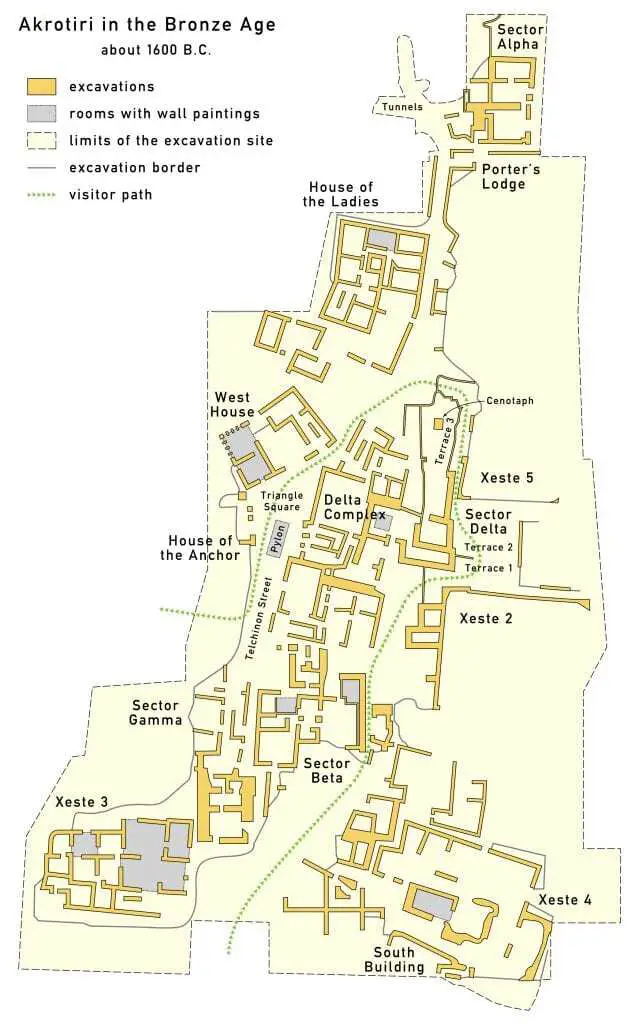During the height of the Greek Bronze Age, a volcano erupted on the ancient Greek island of Thera (modern Santorini). The violent eruption sent six times more magma and rock into the Earth’s atmosphere than the notorious Krakatoa eruption in 1883.
Thera is located in the Aegean Sea, and the effects of the eruption would have had catastrophic effects on the entire Eastern Mediterranean region. The town of Akrotiri, located on the island itself, was buried under metres of volcanic ash, preserving the town in much the same way as Pompeii was preserved by Vesuvius (although the residents of Akrotiri had the forewarning of seismic tremors and evacuated prior to the eruption, for no evidence of bodies has yet been found there, unlike at Pompeii).
The remains of Akrotiri were excavated from the 1960’s by Greek archaeologist Spyridon Marinatos. As early as 1939, Marinatos claimed that the eruption of Thera was responsible for the downfall of the Minoan civilisation on the island of Crete, about 110 kilometres south of Thera. There has been heated debate over this theory ever since.
One major problem with the idea involves looking at pottery styles. The most recent pottery style found in the destroyed Minoan palaces was Late Minoan 1B. Cross-dating between the Minoan sequence and the well-established Egyptian chronology dates Late Minoan 1B pottery (and hence the destruction of the palaces) to around 1450 BCE.
Therefore if the eruption of Thera was responsible for the palatial destruction, it must have occurred at this time. The problem is that the most recent pottery style found at Akrotiri was Late Minoan 1A, dated to around 1500BCE. This led most scholars to conclude that the eruption occurred around this date and was not responsible for the Minoan collapse which occurred later, around 1450 BCE.
However, there are some who do not assume that the end of settlement at Akrotiri coincided with the eruption. It has been proposed that the settlement could have been abandoned years or even decades before the eruption. Akrotiri was, in the first instance, destroyed by earthquakes, and signs of reoccupation and clearance of parts of the town prior to the pumice fall have been cited as evidence for this idea. Most scholars seem to think that there was only around two years between the evacuation and the eruption though.

The effects of such a massive eruption would have been felt across a wide section of the planet, and this is supported by deep-sea cores from locations including the Mediterranean Sea and Crete containing ash found by laboratory analysis to be from the Thera eruption. As such, dendrochronology (tree-ring dating) and ice core samples from distant sites have both been used to attempt to obtain an absolute date for the eruption.
Researchers from Queens University in Belfast found that oak trees living in the bogs of Ireland had narrow growth rings for the decade following 1628 BCE. This date is also supported by the tree-ring sequence of the California bristlecone pine. The researchers argued that these anomalies were caused by a cloud of volcanic dust from the Thera eruption that stunted growth. But the link between the narrow growth-rings and the eruption is tenuous, and does not provide strong evidence for this date all by itself.
Ice cores demonstrate peaks of high acidity caused by major eruptions, and the acidity levels of an ice core from Greenland suggested a similar eruption date of around 1645 BCE. However, a fragment of tephra (volcanic ash) from the ice core in question was shown by further analysis to be unassociated with that particular eruption.
Radiocarbon dating has proven much more effective in establishing an absolute date. A study led by archaeologist Sturt Manning from Cornell University obtained radiocarbon dates from 127 samples of wood, bone and seed from Akrotiri and other Aegean sites. Following calibration and cross-checking among three different laboratories, they date the eruption to between 1660 and 1613 BCE, within 95% confidence intervals.
In 2006, a team led by geologist Walter Friedrich of the University of Aarhus found an olive tree on Thera that had been buried alive by the eruption. Radiocarbon dating gave the tree’s date of death (and therefore the date of the eruption) as 1627-1600BCE at 95% confidence levels, which matches very neatly with the dates from Manning’s study.
The problem is that an eruption date of the early 17th century BCE disagrees entirely with the well-established Egyptian historical chronology, which sets the eruption date at least a hundred years later. Late Minoan 1A pottery has been found in stratigraphic layers that Egyptian records date to later periods, and there is a style of Cypriot pottery found at Akrotiri that does not appear in Egypt until the 16th century BCE.
So while the radiocarbon dates provide a strong case for dating the eruption of Thera to the early 17th century BCE, the pottery finds and well-established Egyptian chronology cannot be discounted. Indeed, if the radiocarbon dates are taken to be the correct ones, the whole of Aegean Late Bronze Age chronology would necessarily be revised. The debate continues.
Written by : Robyn Antanovskii
References:
Balter, M. 2006. New Carbon Dates Support Revised History of Ancient Mediterranean, Science, Vol 312 (28 April 2006).
Friedrich, W.L. et al. 2006. Santorini Eruption Radiocarbon Dated to 1627-1600 B.C., Science, Vol 312 (28 April 2006).
Haughton, B. 2010. Akrotiri and the Destruction of Thera (Greece), History’s Mysteries, Career Press.
Nailing down an ancient eruption, Science News 251 (16 April 1988)
Renfrew, C. & Bahn, P. 2012. Dating the Thera Eruption, Archaeology: Theories, Methods and Practice, Thames & Hudson.
Sparks, R.S.J., Sigurdsson, H. & Watkins, N.D. 1978. The Thera eruption and Late Minoan-1B destruction on Crete, Nature 271 (05 January 1978).
Studies from Cornell University Provide New Data on Archeometry. Science Letter (26 April 2011).
Warren, P. 1984. Archaeology: Absolute dating of the Bronze Age eruption of Thera (Santorini), Nature 308 (05 April 1984).
Header Image Credit : RT44





